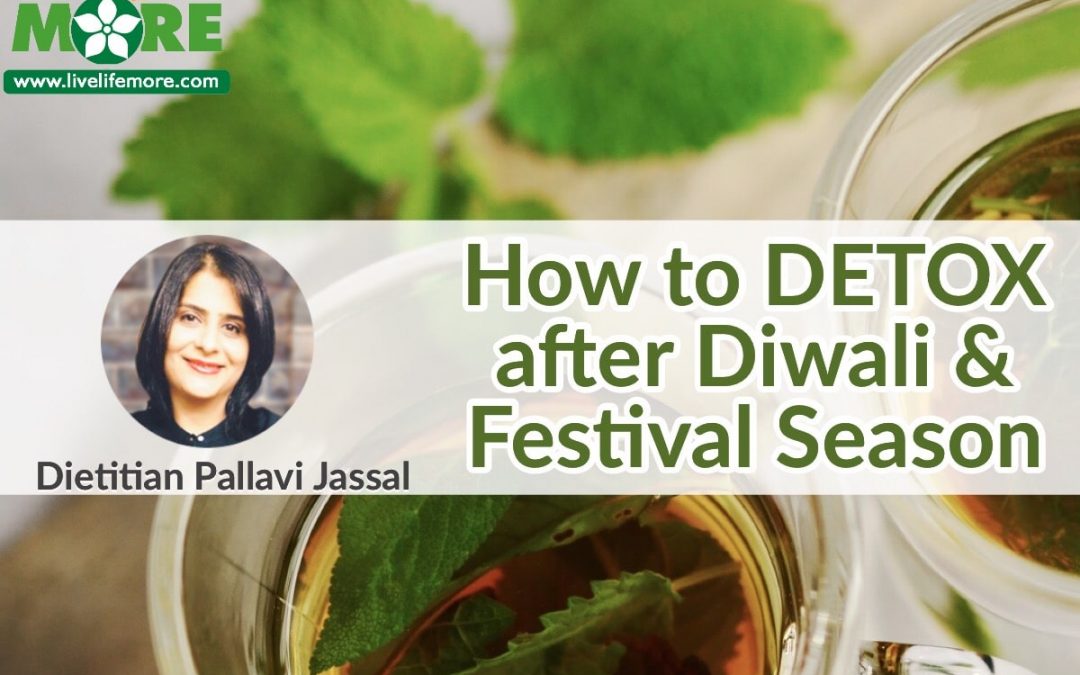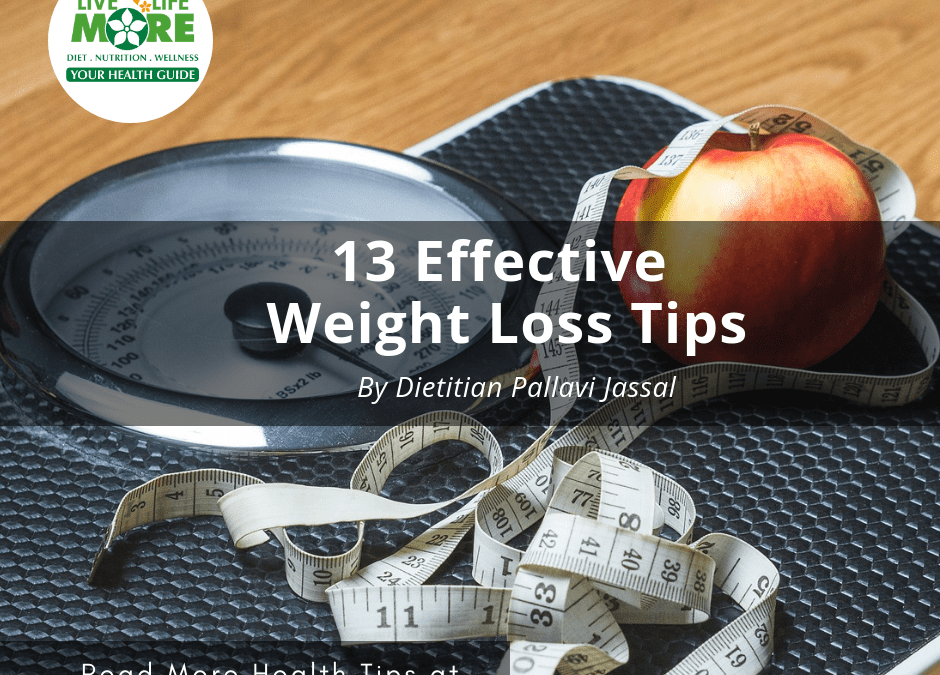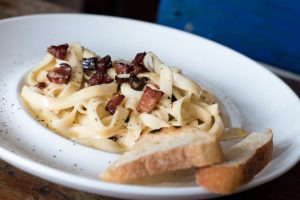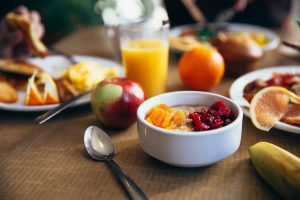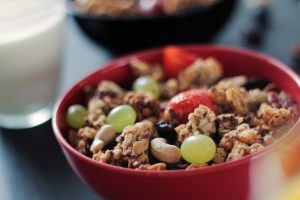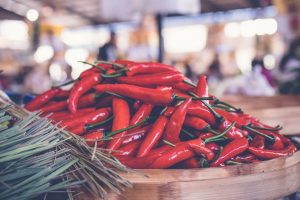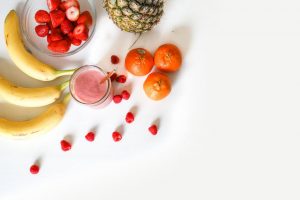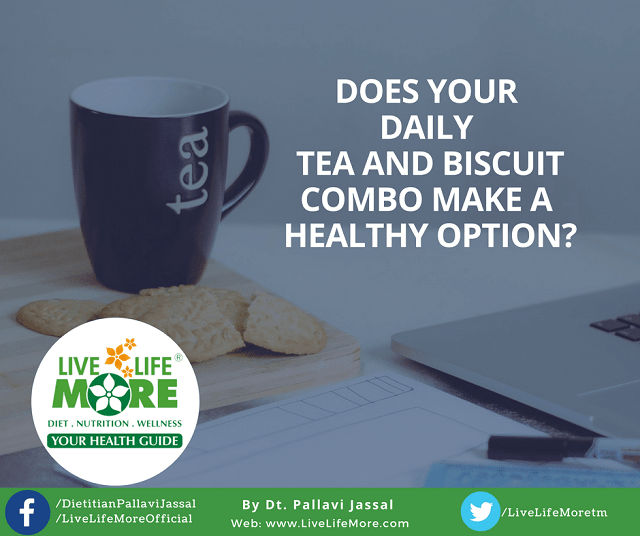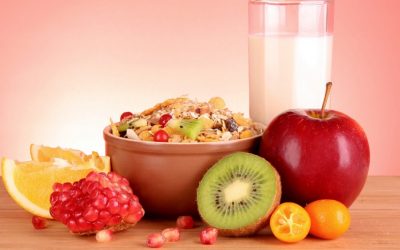
Looking for a simple home remedy to get rid of the heaviness, bloating & constipation? In this article, we are sharing an effective way to Detox after Diwali or Festive Season.
How to Detox after Diwali or Festive season?
You have been meeting friends and family and enjoying their hospitality or have been showing your hospitality. Healthy eating may have taken a back seat during the celebrations. And, now you are feeling bloated, constipation, tired or exhausted and guilty. Aren’t you??
Some herbal tea can help cleanse the body from within by behaving like a natural cleanser and laxative.
Herbal teas are undoubtedly one of the healthiest beverages on the planet. These are loaded with vitamins, minerals, and antioxidants that provide many short and long-term health benefits, including weight loss. Post-Diwali or after eating out too much, you would want to detox your body to get your digestive health back on track. Here comes the role of the herbal teas, such as ginger-basil tea, which is an excellent natural remedy for fighting the harmful effects of indulgence in too many crappy foods and also air pollution.
As the air around us is on the hazardous levels of air pollution, you need something that will not only protect your lungs from the toxic air during the festive season but also helps you burn calories, thus helping you stay fit and healthy. Taking herbal tea can help fight the cold, improve digestion, lower blood pressure, boost up metabolism and provide relief from stress and anxiety. Herbal tea is also good for your skin and hair.
Let me share the recipe of a herbal tea to help your lungs, detox your body and enhance weight loss:
Fresh Ginger and Basil tea for Detoxification, Weight loss, Healthy lungs and more…
Why Ginger?
– Ginger is one of the oldest home remedies that can help ease digestion, nausea and improve appetite.
– Very potent anti-inflammatory and antioxidant properties in ginger can help in relieving congestion and throat pain.
– Ginger tea boosts the immune system and detoxifies the body.
– Ginger is a great weight loss drink by helping you burn more calories.
Why Holy basil Tulsi?
Holy basil, or tulsi in Hindi, has immense health benefits.
– From leaves to the seed, the herb has been used for treating different ailments, such as bronchitis, stomach ulcers, malaria, nausea and vomiting, diabetes, etc.
– Holy basil has excellent anti-inflammatory, antioxidants and immune-boosting properties.
– Holy basil can also help in weight loss and cholesterol management since it improves metabolic stress
How to make ginger basil tea
Ingredients:
• 2 cups boiling water
• 1/2 teaspoon fresh ginger, grated
• 4 -5 fresh basil leaves
Procedure:
• Bring the water to a boil.
• Add the ginger and basil leaves to the water and brew for 5-10 minutes.
• Press the basil leaves gently to get more flavour out of them.
• Strain off ginger and basil leaves.
So this herbal concoction is now ready to be consumed.
You can drink it hot or cold. Let this magic tea detoxify your body, lose weight, overcome the harmful effects of air pollution and smog.
Stay blessed & LiveLifeMore!!!

Weight Loss! This word may be a challenge to some and scary to others but it doesn’t have to be either. In this article, we cover 13 effective weight loss tips that will not only help you achieve your weight loss goal stress-free but also help you become a healthier and happier person as well. If you’re one of those individuals that find it difficult to lose that stubborn belly fat despite following countless diet and exercise fads; don’t fear because there is a solution for you.
So, let’s get started
1. Cut Back on Added Sugar
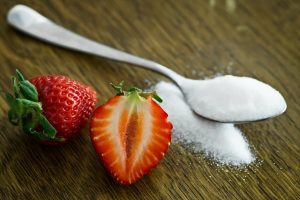
The single most lethal ingredient is known to be added sugar in today’s modern diet. It is known that added sugar is being widely consumed in high volumes
There are numerous studies that show that the consumption of sugar (as well as high fructose corn syrup) has been known to be associated with a number of health issues such as the risk of obesity, type 2 diabetes, and heart disease
If you’re planning to lose weight it is highly advised that you cut back on added sugar.
When taking that path, make sure you carefully read the labels because the so-called “health foods” can be loaded with added sugar.
2. Eat Less Refined Carbs
 Refined carbs are defined to be either sugar or grains which have been stripped of their fibrous nutritious parts (examples include: white bread and pasta)
Refined carbs are defined to be either sugar or grains which have been stripped of their fibrous nutritious parts (examples include: white bread and pasta)
Studies have shown that the if you consume refined carbs it can lead to a rapid spike in blood sugar, hunger cravings and increased food intake a few hours later. Obesity is known to be linked to the consumption of refined carbs
If you’re going to consume refined carbs just make sure that you consume them with their natural fibers intact
3. Exercise Portion Control or Count Calories
 Portion control (also known as eating less) or the counting of calories can be useful for various reasons (ex: losing weight)
Portion control (also known as eating less) or the counting of calories can be useful for various reasons (ex: losing weight)
There are various studies which show that keeping a food journal and recording your meals even taking pictures of the meals can aid you in your journey to lose weight and reach your target weight.
Anything that helps you in increasing your awareness in what you consume is most likely to be very useful to you
4. Keep Healthy Food Around
 An advantage to keeping healthy food around you is that it can prevent you from consuming something unhealthy in case you become increasingly hungry. If you consume something that is healthy over something that is not, it can help you control your weight as well as blood sugar level
An advantage to keeping healthy food around you is that it can prevent you from consuming something unhealthy in case you become increasingly hungry. If you consume something that is healthy over something that is not, it can help you control your weight as well as blood sugar level
There are a number of snacks which are not only considered portable but easy to prepare as well. These include whole fruits, some nuts (the recommended serving is a handful), some baby carrots, yogurt, and one or two servings of hard-boiled eggs.
5. Shift to Spicy Food
 Cayenne pepper contains a compound called Capsaicin that can cause your metabolism to increase and your appetite to reduce slightly. It also is known to bind to the receptors on the nerve fibers that is known to transmits pain and the possibility of heat (this explains the burning effect that you experience on the lining tissue of your mouth when you consume a pepper) It is also known to contain many weight loss properties. There are many kinds of food that contain Capsaicin such as hot peppers and sweet peppers
Cayenne pepper contains a compound called Capsaicin that can cause your metabolism to increase and your appetite to reduce slightly. It also is known to bind to the receptors on the nerve fibers that is known to transmits pain and the possibility of heat (this explains the burning effect that you experience on the lining tissue of your mouth when you consume a pepper) It is also known to contain many weight loss properties. There are many kinds of food that contain Capsaicin such as hot peppers and sweet peppers
6. Do Aerobic and Resistance Exercise
 The best way you can burn the maximum number of calories is through cardio. Cardio is not only useful in burning calories as it is also known to improve your physical health, but it is also known to improve your mental health. Cardio appears to be particularly effective in losing that stubborn belly fat. So, what is belly fat you ask? Well, belly fat is defined as the unhealthy fat that over time builds up around your organs due to a sedentary lifestyle and poor exercise habits; and it is also known to cause various metabolic diseases (high cholesterol, heart disease, obesity, and type 2 diabetes).
The best way you can burn the maximum number of calories is through cardio. Cardio is not only useful in burning calories as it is also known to improve your physical health, but it is also known to improve your mental health. Cardio appears to be particularly effective in losing that stubborn belly fat. So, what is belly fat you ask? Well, belly fat is defined as the unhealthy fat that over time builds up around your organs due to a sedentary lifestyle and poor exercise habits; and it is also known to cause various metabolic diseases (high cholesterol, heart disease, obesity, and type 2 diabetes).
There are many side effects caused by dieting that many are unaware of but one of the worst ones is that it is known to cause muscle loss and the decrease in metabolism (also starvation mode). One of the best ways to prevent this from occurring is to partake in some form of resistance exercise (such as lifting weights). So, what is the point of lifting weights? Well lifting weights can help keep your metabolism levels high and prevent you from experiencing muscle mass loss
Despite the importance of losing unwanted belly fat; one must make sure to do some sort of resistance exercise because it is critical to health.
7. Take More Fiber, Fruits & Vegetables
 Fiber is highly recommended for weight loss; it is not only known to increase satiety but I can also aid you in controlling your weight over a long period of time.
Fiber is highly recommended for weight loss; it is not only known to increase satiety but I can also aid you in controlling your weight over a long period of time.
Fruits and vegetables contain a few calories but most importantly it contains a lot of fiber as well. Not only that they are known to be rich in water, take a while to chew, and are quite filling. If you feel hungry you can eat a piece of fruit or vegetable and it can not only give you many advantages such as your daily dose of fiber, but it can also give you the satisfaction of being full and prevent you from eating unhealthy food.
Fruits and vegetables have many properties that make them a great snack and an excellent choice for weight loss. Why is this? Well fruits and vegetables are very healthy and they also carry many health benefits
8. Chew Your Food Slowly
 After you eat a meal you know that you’re full but it can take your brain a while to process that you have had enough food to eat. Chewing your food slowly during every meal can help in the consumption of fewer calories and also aid in the production of hormones that can aid in weight loss. So, no matter what you eat to make sure that you chew your food thoroughly.
After you eat a meal you know that you’re full but it can take your brain a while to process that you have had enough food to eat. Chewing your food slowly during every meal can help in the consumption of fewer calories and also aid in the production of hormones that can aid in weight loss. So, no matter what you eat to make sure that you chew your food thoroughly.
9. Get a Good Night’s Sleep
 Nowadays sleep is becoming underrated, and the one thing that many fail to understand is that sleep is considered to be essential as well as an important part of life. One important fact that many are still unaware of is that sleep holds just as much importance as eating healthy. Poor sleep habits are a HUGE contributor to obesity, and it is known to have an increased risk of obesity in children than in adults. Getting a proper night’s sleep is really important and it can be beneficial in losing weight
Nowadays sleep is becoming underrated, and the one thing that many fail to understand is that sleep is considered to be essential as well as an important part of life. One important fact that many are still unaware of is that sleep holds just as much importance as eating healthy. Poor sleep habits are a HUGE contributor to obesity, and it is known to have an increased risk of obesity in children than in adults. Getting a proper night’s sleep is really important and it can be beneficial in losing weight
10. Eat More Protein
 The single most important nutrient associated with losing weight is protein. The consumption of protein in your diet causes an increase in the level of metabolism by 80100 calories per day; while helping the feeling of satiated (which is caused by the consumption of fewer than 441 calories per day).
The single most important nutrient associated with losing weight is protein. The consumption of protein in your diet causes an increase in the level of metabolism by 80100 calories per day; while helping the feeling of satiated (which is caused by the consumption of fewer than 441 calories per day).
Protein (which is derived of 25% of your calories) can reduce your obsessive thoughts about food by 60, while at the same time cutting your need to late night snack by up to 50%. Simply adding protein to your diet (with restrictions of course!) can be an effective way to lose weight.
11. Avoid Dieting, Just Eat Healthy
 One of the biggest issues with many diets is that they almost never work in the long term. Those who diet end up gaining more weight over time and that dieting is considered to be a predictor of weight gain in the future. If you’re looking for an alternative to dieting, you’re in luck because fortunately, one exists. One thing that you can do is that you can set a goal of becoming healthier, happier, and fitter person. One should focus on providing the body with nourishment rather than depriving it
One of the biggest issues with many diets is that they almost never work in the long term. Those who diet end up gaining more weight over time and that dieting is considered to be a predictor of weight gain in the future. If you’re looking for an alternative to dieting, you’re in luck because fortunately, one exists. One thing that you can do is that you can set a goal of becoming healthier, happier, and fitter person. One should focus on providing the body with nourishment rather than depriving it
12. Supplements & Whey Protein
Those who struggle with getting enough protein in their diet should consider taking a supplement as an aid while in the process of losing weight. If you take the decision to replace part of the calories with whey protein it has positive benefit such as the result in the loss of 8 pounds while causing an increase in muscle mass
13. Beat Your Food Addiction
Food addiction is known to be a factor in obesity, and many still remain unaware that they may suffer from a form of food addiction. One way you can find out whether or not you have food addiction is to see if you suffer from an overpowering need to eat all the time and if you’re able to keep your food intake under control. If by chance you do suffer from food addiction, it is strongly advised that you seek some form of help as soon as you can; because it is impossible if you try to lose weight before you deal with this issue first.


Is it good to have tea and biscuit in the morning?
Imagine your life without the Tea and Biscuit combo especially if you are from north India. For most of us, the moment of sheer relaxation is the moment of holding a hot cup of favorite tea with a tray filled with the variety of biscuits. It’s been a custom to entertain ourselves or our guests with this so-called light snacking option. Not just at home, a piping hot cup of tea is sold like hot-selling cakes in every street of India.
Everyone has a specific preference for his type of tea like Milk Tea, Masala Tea, English Breakfast, Darjeeling green, Oolong Tea, Green Tea, White Tea, Yellow Tea, Dark Tea, Black Tea etc. Similarly, biscuit fans have a wide list of varieties available nowadays on market shelves. But, for weight watchers, the most common trend these days to consume the digestive version of biscuits and not the common biscuits. Can you relate to this???
Well, if you think that biscuits are healthy… The answer is NO… all the varieties of biscuits or cookies are just the same & can truly be categorized as processed foods, no matter what brand name has been printed on the packet.
This article thus brings out some eye-opening nutritional facts about the so-called & believed combination of TEA & BISCUITS.
FACTS ABOUT TEA
India is a largest tea drinking country in the world. But consuming as the first thing after you wake up or drinking it too frequently throughout the day, is not a wise choice. Wanna know why…
- It increases acid production in the stomach – Our stomach produces acid (HCl/ Hydrochloric Acid) to digest food well. Even at fasting state, the ph of the stomach remains acidic around 1-2. Thus, consuming tea as the first thing in the morning after overnight fast or consuming it as the main fluid source in a day, can lead to hyperacidity and thus, gastric problems like ulcer, bloating, constipation can happen.
- It causes dehydration because drinking too much tea may have diuretic action i.e. increasing urine output. Tea results in water to be drawn out from the tissues causing dehydration.
- It may cause indigestion, due to the presence of milk as an important ingredient, tea can cause symptoms of indigestion.
FACTS ABOUT BISCUITS
The eye-catching word on the packet is WHOLEMEAL WHEAT FLOUR – used as the main ingredient. But actually, these biscuits are mass produced that contain primarily whole wheat flour, malic acid, & tartaric acid, vegetable oil, powdered skim milk, sugar and of course baking soda (sodium bicarbonate). The baking soda in the baked goods will not help in digestion because the heat of the baking oven alters its properties but surely has sodium intact which can increase blood pressure or increase water retention.
How many digestive biscuits do you eat each time? The most common answer is …TWO!! But from a health expert’s point of view, you should not incorporate even the digestive biscuits in bulk quantity in your routine diet.
Two digestive biscuits contain about:
- 150 calories.
- 20 g carbs.
- 5 g Sugar.
- 2 g proteins.
- 1 g fiber.
A single biscuit contains about 75 calories. Proving them to be high in energy with very little nutritional value.
On the contrary, a large apple contains around 90 calories with loads of additional nutritional value. Or a fistful of roasted nuts is also a better option to munch.
Don’t choose by name, know what’s actually in!
All biscuits are made from similar ingredients & are not exactly a great source of nutrition as commonly believed. The usual ingredients in a digestive biscuit are-
1. SUGAR- The sugar content of digestive biscuit may not be as high as regular biscuits but is enough to not to be considered healthy. Each biscuit has around (3-5) grams of sugar. And as obvious effects, regular consumption of added sugar is not good for your waist, blood sugar levels & heart too.
2. FLOUR- Although claimed to be commonly whole wheat flour or oats, but it is the smaller particle size which is needed to make a biscuit in a semi-refined form of flour. Moreover, the processing of wheat does lead to a loss of vitamins, minerals & even bran. Thus, it may not be the best choice for including fiber in the daily menu.
3. FATS- Contrary to what is expected, a whopping amount of 3-5 grams of saturated fat is present per digestive biscuit.
4. SODIUM – You will be surprised to know that taking 4 digestive biscuits is equal to nearly a bag of potato chips! That’s really a matter of concern for our heart health or for the people with high blood pressure, who eat these biscuits mistaking them to be a healthier option.
5. PRESERVATIVES- Added to increase the shelf life of a product. Always bear in mind that any product with more than 2 weeks of shelf life will be loaded with chemicals called preservative to prevent or slow down biological deterioration.
Nutritional Values of common varieties or brands of biscuits available in India
Given below is the broad analysis of nutritional contents of common varieties or brands of biscuits available in India
SUMMARY-
Tea and biscuits seem a tempting combination in which tea is a rich source of antioxidants called Catechins, which are beneficial when consumed in limited quantities at appropriate timings. Overconsumption of this universally favorite morning beverage is harmful to our gut & waist.
Optionally, feeding oneself with 3-4 cups of healthy alternatives like green tea, herbal tea or lemon tea could make a great difference from antioxidant as well as digestion point of view. Also, it is the need of the hour to strictly avoid munching not so healthy options like digestive biscuits, as they are:
- High in fat, particularly saturated fats.
- Low in vitamins and minerals.
- High in sugar and sodium.
- Typically, biscuits consist of highly refined or semi-refined flour & chemically hardened vegetable oil.
- The healthy seeming words like oats & dried fruits often contain more sugar than standard biscuits.
- The worst thing is trans fats.
Hope the information above is helpful to you and your loved ones. Give a like if you found it useful and do share it.
Stay blessed, stay informed & Live Life More 🙂


Courtesy: Pankajakasthuri Herbals India
In this article, we’re going to explain top 12 ways to eat healthy in Navratri fasting diet tips. It is important to eat small meals at regular intervals. This will keep your metabolism fast.
Navratri Fasting Diet Tips
Navratri 2019 Best Ways To Eat Healthy In Fasting
- Replace fried foods with non-fried options and include more of yogurt, smoothies, lassi and fruits which not only will keep you full but maintain the optimum fluids in the body.
- Instead of puri or pakodas made from Kuttu atta, try out Kuttu ki roti, replace fried aloo-chat with boiled aloo-chat and kheer with mixed-fruit curd or flavored yogurt.
- If your taste buds please and time allows, make some idli and dosa from the samak ke chawal.
- Limit your potato intake to about twice a week.
- Replace whole milk with skimmed milk or double toned milk for desserts.
- Substitute sugar in a sweet dish with natural sugars.
- Keep drinking water, coconut water, lemonade (without sugar), herbal teas …as much as you can. It works as a great detox.
- Eating veggies like pumpkin and ghia (bottle gourd) in different forms like soups and curries to fill you up with fewer calories.
- Use rajgira flour to make chapattis instead of using kuttu ka atta. It’s lighter and low in calories.
- Be fruit-friendly this Navratri. Try including fresh fruits in your diet in various forms of salads, smoothies and raitas to keep up with your nutrition, Fruits have healthy sugar fructose. Seasonal fruits boost the immunity and fiber, iron and B6 intake to supercharge your metabolism.
- Instead of having namkeens and pakodas as snacks, have a handful of roasted makhanas or a handful of nuts like almonds, pistachios, walnuts or hazelnuts.
- Drink low-fat milk, lassi, and yogurt, it reduces your cravings to eat junk food. Add cucumber, lauki or tomato to your yogurt to make it more filling.
So, enjoy your food and great health these Navratras. Wish you all a very Happy Navratri 2019 from the team of LiveLifeMore®


Dear Parents & Students, the exam season is around the corner.
Coffee might seem like a favourite answer to how to avoid sleep during exams however, it is seriously not recommended. Not only is it dehydrating, the initial boost can be followed by a serious low. Also, too much tea or coffee can cause heartburn and acidity.
Existing on coffee, energy drinks, and junk food while cramming for exams is common among students. No wonder many students find themselves feeling exhausted, unfocused, and nervous on the big day instead.
Special Exam Diet Tips
Eating healthy food can help you boost memory, improve concentration and achieve top results. Here’s how.
- Enjoy regular meals.
- Stop for small snacks which include yoghurt, a handful of nuts or nuts mixed with dried fruit, a bowl of cereal with milk, a banana or other fresh fruit, 3-4 rice cakes or crisp bread spread with peanut butter or cheese, hot milk and honey.
- Eat food rich in iron and zinc for improved memory and concentration. These are lean red meat, fish and seafood, chicken, nuts and whole grains such as brown rice, whole grain bread and wholegrain breakfast cereals.
- The levels of vitamin C in the body varies greatly with the physical and emotional stress. It dips when subjected to a lot of stress. So you need to add Vit C and B in your diet which includes vegetables, legumes, yeast spread, wheat germ, good grains, oranges, strawberry, guava, black currant, etc.
- You can top up your omega-3 fats by consuming oily fish like salmon, mackerel, tuna, halibut, trout; seeds like flax, chia, melon seeds, sunflower also provide omega-3 fats. You can make a powder of the seeds and nuts and drizzle them over soups, dals, salads, chapatti flour, and almost anything you can think of.
- Water is your best friend. Drink at least 2 litres of fluid to stay hydrated and prevent fatigue. Ideally, most of this should come from water, but tea, clear soup low-fat milk and juices also contribute.
Diet for Exams: General Guideline
Early morning: 3-4 soaked almonds with the skin and 3 walnuts.
Breakfast: 1 glass of milk / Fruit milkshake without added sugar + 2 Whole grain bread and egg omelette sandwiches/ 1-2 whole grain or multigrain wrap or chapati with baked beans and veggie saute / 2 mixed veg and paneer parantha with a bowl of low-fat curd /1 bowl of savoury (with chopped veggies and masala) or jaggery sweetened oats with seeds, fruits and nuts.
Mid-morning snack: 3-4 Flaxseed and till laddoos or dry fruit laddoos + 1 glass of whey protein shake/ A colourful fruit platter.
Lunch: If you’re a non-vegetarian it would be wise to include oily fish twice a week in lunch.
3 chapattis + 1 bowl fish curry + 1 bowl sprout salad / 1 bowl brown or red rice + 1 bowl of palak dal with Seeds Cocktail
Half an hour after lunch: 1 glass buttermilk.
Either make spicy curries or make a smoked salmon sandwich for lunch. Make a powder of the seeds and nuts and drizzle them over dals, soups, salads, chappati flour, and almost anything you can think of.
Mid-evening snacks: 1 bowl of fruit and nut muesli with milk / 1 plate of moong sprout veg red rice poha + 1 glass of fruit milkshake.
Dinner: 1 bowl grilled chicken or fish preparation + 1 bowl brown rice pulao + 1 small bowl mixed veg raita / 1 glass of skimmed milk + 2 Whole grain Chicken veg sandwich.
Post dinner snack if needed: Trail mix containing seeds, nuts and fruits / puffed quinoa and pulse snacks; healthy khakras; flaxseed and til laddoos; healthy cookies made from oats, jowar and other whole grains.
What should you eat before an exam?
For morning exams:
Concentration, performance and memory are higher if you eat in the morning.
Try cereal and low-fat milk or toast with a spread. Also, you can eat some fruit (fresh or canned), an egg, yoghurt or baked beans on toast.
For afternoon exams:
Have a light lunch that won’t have you nodding off with post-meal sleepiness.
A bowl of soup and bread roll
OR
A sandwich or wrap filled with lean meat or chicken and salad.
